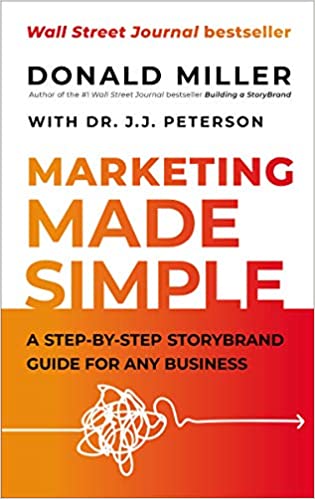Marketing Made Simple — Book Summary
Introduction
The marketing plan and execution profoundly influence the success of any business. The sales funnel is the base of any digital marketing plan. It helps to capture lead and conversion.
An interesting quote from the book
Your customers are not curious about you; they are curious about how you can solve their problem.
— Donald Miller, Marketing Made Simple
Summary of the book Marketing Made Simple
There is a need to know that 'most marketing plans do not fail in philosophy; they fail in execution.'
All sellers wish that people buy products because the products solve their problems. But only asking customers to buy doesn't convert to real sales. Sellers need to have the correct approach to selling.
Like any relationship, relationships with customers move through three phases, and not following these stages will jeopardize marketing efforts.
These three stages are:
- Curiosity
- Enlightenment
- Commitment
The curiosity stage
The curiosity stage is when we decide whether a product will benefit or help us survive. Here the target market makes a case for competitive products; they list out all the things they want and cross-check if your product meets that requirement.
To make your product different and pique curiosity, associate your products with challenges your target market faces and how your product can solve them.
The enlightenment stage
The enlightenment stage is where your customers begin to trust you. Enlightenment invites customers into a relationship with you. You can do this by explaining how you can solve their problem and assist them in surviving.
The commitment stage is the final phase where your customer makes a decision. Don't rush your customers' relationship; instead, invite them on a journey at a natural and healthy pace.
The author further explains that branding is not marketing, and confusing these two concepts might lead to severe financial implications. Branding concerns itself with how a customer feels about a product while marketing communicates a specific offer. If you focus more on branding at the initial stage, you will likely forget why you are making a sale. Marketing should always be your initial motive.
Important questions
When you want to create a sales funnel, ensure the target audience knows about you.
Consider answering these salient questions in your sales funnel.
- What problem do you solve for customers?
- What will your customers become if they buy your product?
- What consequences does your product help the customer avoid?
The answers to these questions should be concise and easy to understand.
The five pieces of the sales funnel
- One-liner
- Website
- Lead generator
- Nurture campaign
- Sales campaign
One-liner
First, start building curiosity for your business by using a one-liner and website wireframe. After that, you take the customers through the enlightenment phase using lead generators and nurture email. And finally, you ask them to commit to a sales sequence.
This is a concise statement you can use to explain what you offer clearly. It's comprised of three parts: the problem, the solution, and the result.
When you start with the problem, you've created a hook, and your customer will give you uninterrupted attention because they can relate to what you're saying.
The next is the solution. At this stage, the customer is ready to hear about the solution. Connect the problem with the answer to have the desired result and avoid using "cute and clever languages as a substitute for clarity."
The last step is the result, and this is the final part of the one-liner. It should also connect with the problem and the solution. When you write about the answer, add "which results in" to all the customers feel emotion.
For example, if you're a roofer, you can write, "You'll get a good roof which results in a worry-free home."
Use the one-liner technique in your business card, email signature, make it your first sentence in your about us section, and use it for your profile description on social media.
Website
The website should not only be about lofty design, colors, images, and "feel." It should also examine the way the words are structured. Your website needs to include words that sell and grow your business.
Your website is not a place to fan yourself. It's where you sell your customer a product that solves their problems and makes their lives easier for them.
Start your website with a wireframe, and a wireframe is a long piece of paper or digital page that includes the text in a rough draft drawing of the outcome of the site.
Nine sections of the website have proven to increase sales; the more you use them, the more you earn.
- The header
- The Stakes
- The value propositions
- The Guide
- The Plan
- The explanatory Paragraph
- The video(optional)
- Price Choices
- Junk Drawer
The header
The header is the first impression a customer has about your product or service. You should ensure your header piques the customer's curiosity.
The header should provide clear information such as what you offer, how it will improve the customer's life, and what he needs to do to buy it. Don't use a passive-aggressive tone for your call to action, e.g ., "Learn more." Let your objective be known early and often. Use a strong call to action.
The Stake
The stake is the failure section. When you mention the negative consequence or how much it costs your customers to live without your product, they begin regarding your product as the solution they need. The Value proposition is the benefit your customers stand to gain when they use your merchandise. The added value they get when they buy your product, e.g. save money, save time, improve productivity, etc.
The Guide
The guide involves the expression of empathy and authority towards the customer. When we show compassion and influence, we give our customers assurance. You can demonstrate authority in your website via the testimonial, logos of brands you've worked with, and simple statistics.
The Plan
If you have a path for your customers, they will follow it. The plan lists and highlights the procedure your customers need to follow to do business with you. Keep the project visually simple and state the benefit of each approach.
The Explanatory Paragraph
Including long-form text using words that sell your products will increase your chance of having search engine optimization content (SEO). People don't like buying impulsively, and when they do, they want to believe they'd researched before committing to buy.
The video
Many people prefer visuals to written words. Therefore your video needs to repeat what has been written. Make it enjoyable to hook the customer.
Price choice
Having three different pricing options for the same product is encouraged. Consider packaging other items with that merchandise because customers like having options. When you give them a few options, they will choose one.
Junk Drawer
Move some vital information like contacts, FAQ, about us to the bottom page so people can easily find them.
Lead Generator
If you want people to stay in touch with you, consider offering them something of value. You can create a lead generating PDF to achieve this purpose. Here are some ideas you can use to provide value to customers: Capture an interview with an industry expert, create a checklist, make a worksheet your audience will use over and over, host an educational event, the sampler, webinar, pitfall list, and open house. The sole aim of the lead generator is to earn a space in your customer's inbox. Two types of email campaign highly recommended are:
- Nurture campaign: Designed to keep in touch with a potential customer
- Sales campaign: Designed to close the sale.
Nurture campaign
The nurture email campaign or drip campaign slowly drips information to customers over a long period. Customers will have to hear about a product five times or more before willing to buy. The number of emails does not require thinking. You can send as many as you want while always providing value. The nurture email can contain weekly tips, weekly announcements, or notifications to the customer.
Sales campaign
Creating an email sales campaign is your opportunity to share the full story of how your product will solve customers' problems and a means for them to purchase it. Here is a natural sales sequence you can create.
- Email 1: Deliver the asset.
- Email 2: Problem plus solution.
- Email 3: Customer testimonial.
- Email 4: Overcome an objection.
- Email 5: A paradigm shift.
- Email 6: Sales email.
The idea behind a sales email is to give the customers something to accept or reject. A sales campaign doesn't convert everyone; some people will still not make a purchase, which's okay. Starting with a sales campaign is recommended for at least a week before putting people into a nurture campaign to maintain the relationship.
Key Lessons
Lesson 1: The best marketing plan starts with a sales funnel
A sales campaign funnels the necessary foundation of a good marketing plan because it is the way to capture and convert leads.
Lesson 2: If you want customers to commit, pique their curiosity and enlighten them
Building a lasting relationship with customers involves these three stages; curiosity, enlightenment, and commitment.
Lesson 3: You must keep in touch to create a good relationship with your customers
Touch refers to an email, a visit to the website, a radio ad, or any other marketing collateral.
Review of the book Marketing Made Simple
Donald Miller did an excellent job in this marketing guide. He has made everything practical for any business owner. The email templates can be used for any sales campaign regardless of the industry. Overall, it is a book worth anyone's time.
Conclusion
Indeed, marketing was made simple in this book. Gave an in-depth discussion on best practices in sales funnel creation and campaign.
I would recommend this book to anyone who wants to take his business to the next level. Especially the business owners that are just transforming to the digital space. This book might be all you need for successful digital marketing execution.
Don't miss the other book summaries on SunInMe.org

